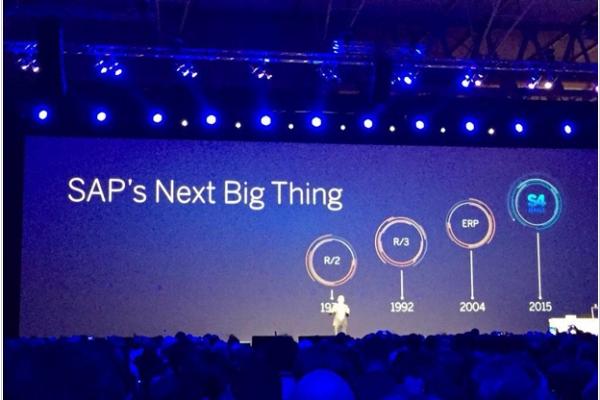Published on the 29/10/2015 | Written by Donovan Jackson

When big organisations undergo significant change, the impact on customers has to be carefully handled…
SAP is working pretty hard to dispel the notion that it is an ERP company (although it certainly is that). Meeting with iStart at its recent APAC media summit and quizzed about his position, chief customer officer Daniel Nimmo started off by explaining why a CCO position exists in the first place. “I’ve been in the role for 18 months; why are we doing this? The journey SAP is on is meteoric in terms of change. We’ve spent 30 years as ERP vendor and that is how we are perceived by the market.” No shame in that, but even ERP is moving towards utility status. For any company over a certain size (and even for some pretty small ones – SAP showcased a customer which has just 6 users on its B1 system, running 15 chicken restaurants), an ERP system is a practical prerequisite. But growth, innovation and dollars don’t typically come from utilities. “SAP saw the need to widen its platform to address changes in the market, to transform the business. The world has changed with cloud and platform and mobility and BI, so in effect we’ve created a bit of monster with how take the whole thing and ‘SAP-ise’ that,” said Nimmo. “The challenge was how to stay aligned with our customers which, with a large existing base, has a perception of who you are. We had to start from the customer and work back.” He described his role as that of ‘customer advocate’ and even ‘devil’s advocate’. “That means spotting things that don’t align. It means maintaining the good stuff while changing ourselves.” What’s in a name? HANA, for the most part The most recent version of its ERP is called S/4 HANA. In memory database – HANA. Platform as a service? HANA Platform. Private cloud? HANA Enterprise Cloud. New big data analytics solution? HANA Vora. When demonstrating a solution for sports, Nimmo’s colleague, Puneet Suppal asked the assembled media to answer a question on what made such things possible with ‘HANA’- but it seemed few knew what the word actually meant, if indeed it means anything at all. Three areas of focus to manage change The second, “We run a number of programmes to facilitate change; customers may not be leveraging maximum value out of their SAP investment, so set up programmes to reawaken customers to what they are not doing and what they could be doing. We even work to change the view that customers have of their business and what their value add actually is, to help them run better. We prod a bit make customers think about it.” Thirdly, “Once customers understand what they have got, we work to help extend the use. CEOs like to talk about leveraging assets to the max, but is that really the case? We ask the question,” Nimmo said. From ERP to EAS While SAP was pushing the ‘Run Simple’ theme at the media summit, few of the reporters were buying the line, as SAP is itself an immensely complex organisation which helps other, quite often equally, complex organisations to get a handle on their operations and strategy. Cloud is a big deal for SAP, as is services. Quite aside from its various HANA products – which, to demystify to an extent, are built around the company’s in-memory database and computing platforms (called, unsurprisingly HANA), SAP has literally hundreds of products and thousands of modules. How HANA ‘runs simple’, however, is that it looks to reduce IT complexity by removing the need for separate and multiple application servers, operational data stores, datamarts and complex BI tool implementations. Or, in one sentence, operational and analytics information is the same thing – no more extract, transform and load, or repurposing of information for different users. There’s even more to it than technology, as SAP is also looking to cast the innovation net wider. Nimmo explained that as it seeks to provide ‘total solutions’, SAP is today partnering with a far greater cross section of organisations, the likes of which occasionally come as a surprise to observers. “Companies like Rockwell, Schneider Electric, even farmers. We’re focusing on the needs of a community rather than the needs of the vendor at the centre. So when I engage with customers, we talk about how to get sustainability into that. That is a different conversation from business as usual.” Donovan Jackson attended the APJ Media Summit as a guest of SAP. … Are buyers looking for AI features? Or is the reverse more true? Xero deals and MBIE and Aussie govt plans… Realities of Rise, SAP’s latest subscription model… Five tips that can change fortunes… Covid-19 has created a clash of market drivers. Which will out?…
As for things that don’t align, one of the realities that SAP has to deal with is market confusion. In its work to change the commonly held perception of the company as an ERP provider, the range of products, services and solutions available from SAP is somewhat difficult to ascertain, perhaps not helped by the tendency to name as many things as possible HANA.
Continuing, Nimmo said that in managing change, there are three areas of focus in the process of looking at things from the customer perspective. The first, “How do we engage, what is the sales, service and support engagement?”
But, outside of HANA, just how is SAP changing, then? It’s going from ERP to EAS – that’s enterprise application software. It’s getting big on the cloud; again, looking to push away the perception that it is an on-premise software provider (though it is certainly that).FURTHER READING

The evolving role of AI in business technology

E-invoicing: Because cashflow is king

Will local SAP customers Rise to cloud transition?

Best practise ERP selection and evaluation

ERP market gets cloudier



























